load capacity INFINITI QX80 2021 Towing Guide
[x] Cancel search | Manufacturer: INFINITI, Model Year: 2021, Model line: QX80, Model: INFINITI QX80 2021Pages: 26, PDF Size: 0.6 MB
Page 2 of 26

2021 INFINITI Towing Guide
1
SAFETY IS PRIORITY ONE
Obviously, your first concern should be safety. Your vehicle was designed to be used
primarily to carry passengers and cargo. Always remember that towing a trailer places
additional loads on your vehicle’s engine, drivetrain, suspension, steering, braking, and
other systems. Therefore, be certain that your vehicle can meet the demands of the towing
application you have in mind.
Rent or purchase only the highest-quality towing and safety equipment you can find.
Reinforced tow hitches designed especially for certain INFINITI vehicles are available from
your INFINITI retailer. Hitches for other INFINITI models — if INFINITI recommends towing
with that vehicle — should be bought from and installed by a professional supplier of towing
equipment. Carefully review all information and literature provided with any hitch you
purchase for safety and proper use information. Finally, it is important to follow the towing
capacity limit set for your specific vehicle and to ensure that your vehicle is in top
mechanical condition, especially the tires, brakes, suspension, and engine cooling system.
See your vehicle owner’s manual for details.
NEVER EXCEED THE ESTABLISHED TOWING CAPACITY
Towing capacities vary from vehicle to vehicle. See the towing information in your vehicle
owner’s manual to confirm whether your 2021 INFINITI vehicle can be used for towing and
if so its towing capacity.
EQUIP YOUR INFINITI FOR TOWING
The frequency and type of towing dictate the manner in which you equip your vehicle. If
you plan to tow often, either for recreation or work, select the engine size, transmission
type, suspension, and towing capacity that are best suited to your requirements. This guide
can help you select the proper equipment.
READ THIS GUIDE BEFORE YOU TOW
This guide was designed to provide an overview of safe towing practices. Here, you will
find information on towing equipment, safety, proper loading and driving techniques,
towing tips, and much more.
It is also a good idea to discuss your towing requirements with either your INFINITI retailer
or a professional supplier of towing equipment before you equip your INFINITI vehicle for
towing. Finally, there are state and local laws on towing that you should review to ensure
compliance with all regulations.
CAUTION: INFINITI recommends you do not use your new vehicle to tow a trailer or
haul a heavy load for the first 500 miles (800 km) of use. Your engine, axle or other parts
could be damaged. For the first 500 miles that you tow a trailer, do not drive over 50 mph
and do not make starts at full throttle. This helps your engine and other parts of your
vehicle wear in at heavier loads.
INTRODUCTION
Page 3 of 26

2021 INFINITI Towing Guide
2
RENTING
The first thing to keep in mind when renting any type of tow equipment, trailer or tow dolly
is to rent only from professional companies that specialize in towing and towing equipment.
Specialized companies should hire professional staff that can assist you in selecting and
installing the proper towing equipment for your INFINITI vehicle.
When renting, make sure you have your vehicle owner’s manual on hand so that you can
reference the towing capacities for your specific vehicle. Make certain that the tow
equipment and components you rent do not exceed your vehicle’s maximum towing
capacity. Make sure that any related towing equipment you rent has the proper weight
class rating for your maximum intended towed load weight, and the maximum Gross
Combined Weight Rating.
While you are at the rental company, ask questions. How much does the empty trailer
weigh? How much weight will the trailer hold? What is the trailer’s tongue load? With what
type of brakes is it equipped (if any)? All of these factors have an effect on whether your
INFINITI vehicle is capable of safely pulling that type of trailer, dolly, or piece of tow
equipment.
Make certain that the trailer stoplights, taillights, turn signals, and brakes (if equipped) are
connected and are operating correctly, and that all safety equipment is properly installed.
Check the safety chains/cables, tie-downs, etc.
For safer operation, carefully inspect the condition of the trailer and towing equipment.
Specifically, check to make sure the tires are not worn excessively and are properly inflated.
Make sure there are not any broken welds, missing bolts, and that the hitch components
are not damaged. Towing safety should be a high priority when choosing and renting
towing equipment, including hitches.
WARNING: NEVER RENT A CLAMP-ON-TYPE HITCH. The hitch should not be
attached to or affect the operation of the impact-absorbing bumper. Use only a
permanent-type hitch properly attached to the vehicle to help avoid personal injury or
property damage.
PURCHASING
If you are buying a trailer, be sure that your INFINITI vehicle has the towing capacity to pull
it. Refer to your vehicle owner’s manual for detailed information regarding the towing
capacity of your specific vehicle. Your vehicle owner’s manual should ALWAYS be
referenced before making any towing decisions.
TOWING EQUIPMENT
Page 4 of 26
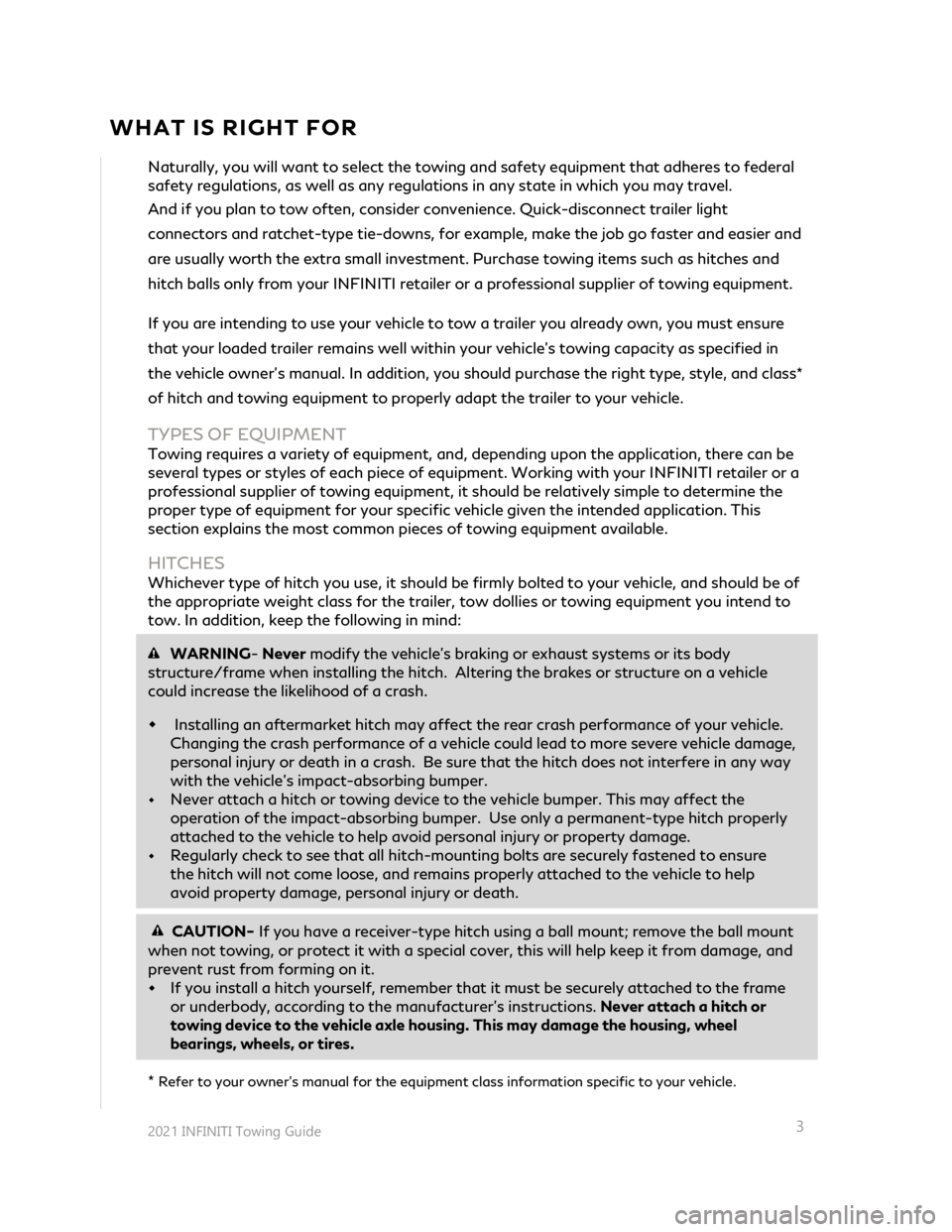
2021 INFINITI Towing Guide
3
Naturally, you will want to select the towing and safety equipment that adheres to federal
safety regulations, as well as any regulations in any state in which you may travel.
And if you plan to tow often, consider convenience. Quick-disconnect trailer light
connectors and ratchet-type tie-downs, for example, make the job go faster and easier and
are usually worth the extra small investment. Purchase towing items such as hitches and
hitch balls only from your INFINITI retailer or a professional supplier of towing equipment.
If you are intending to use your vehicle to tow a trailer you already own, you must ensure
that your loaded trailer remains well within your vehicle's towing capacity as specified in
the vehicle owner's manual. In addition, you should purchase the right type, style, and class*
of hitch and towing equipment to properly adapt the trailer to your vehicle.
TYPES OF EQUIPMENT
Towing requires a variety of equipment, and, depending upon the application, there can be
several types or styles of each piece of equipment. Working with your INFINITI retailer or a
professional supplier of towing equipment, it should be relatively simple to determine the
proper type of equipment for your specific vehicle given the intended application. This
section explains the most common pieces of towing equipment available.
HITCHES
Whichever type of hitch you use, it should be firmly bolted to your vehicle, and should be of
the appropriate weight class for the trailer, tow dollies or towing equipment you intend to
tow. In addition, keep the following in mind:
WARNING- Never modify the vehicle’s braking or exhaust systems or its body
structure/frame when installing the hitch. Altering the brakes or structure on a vehicle
could increase the likelihood of a crash.
Installing an aftermarket hitch may affect the rear crash performance of your vehicle.
Changing the crash performance of a vehicle could lead to more severe vehicle damage,
personal injury or death in a crash. Be sure that the hitch does not interfere in any way
with the vehicle’s impact-absorbing bumper.
Never attach a hitch or towing device to the vehicle bumper. This may affect the
operation of the impact-absorbing bumper. Use only a permanent-type hitch properly
attached to the vehicle to help avoid personal injury or property damage.
Regularly check to see that all hitch-mounting bolts are securely fastened to ensure
the hitch will not come loose, and remains properly attached to the vehicle to help
avoid property damage, personal injury or death.
CAUTION- If you have a receiver-type hitch using a ball mount; remove the ball mount
when not towing, or protect it with a special cover, this will help keep it from damage, and
prevent rust from forming on it.
If you install a hitch yourself, remember that it must be securely attached to the frame
or underbody, according to the manufacturer’s instructions. Never attach a hitch or
towing device to the vehicle axle housing. This may damage the housing, wheel
bearings, wheels, or tires.
*
Refer to your owner’s manual for the equipment class information specific to your vehicle.
WHAT IS RIGHT FOR
Page 6 of 26
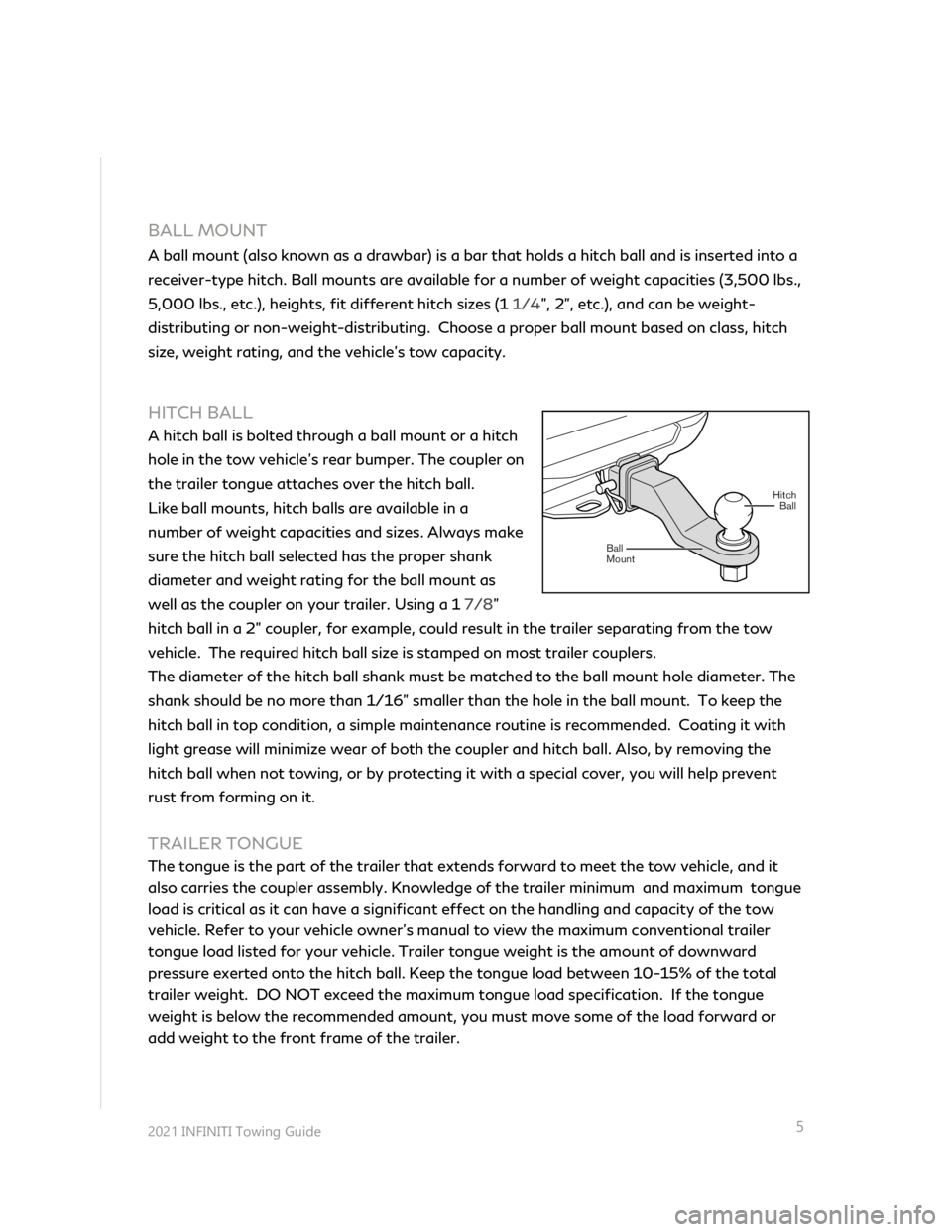
2021 INFINITI Towing Guide
5
BALL MOUNT
A ball mount (also known as a drawbar) is a bar that holds a hitch ball and is inserted into a
receiver-type hitch. Ball mounts are available for a number of weight capacities (3,500 lbs.,
5,000 lbs., etc.), heights, fit different hitch sizes (1 1/4”, 2”, etc.), and can be weight-
distributing or non-weight-distributing. Choose a proper ball mount based on class, hitch
size, weight rating, and the vehicle’s tow capacity.
HITCH BALL
A hitch ball is bolted through a ball mount or a hitch
hole in the tow vehicle’s rear bumper. The coupler on
the trailer tongue attaches over the hitch ball.
Like ball mounts, hitch balls are available in a
number of weight capacities and sizes. Always make
sure the hitch ball selected has the proper shank
diameter and weight rating for the ball mount as
well as the coupler on your trailer. Using a 1 7/8”
hitch ball in a 2” coupler, for example, could result in the trailer separating from the tow
vehicle. The required hitch ball size is stamped on most trailer couplers.
The diameter of the hitch ball shank must be matched to the ball mount hole diameter. The
shank should be no more than 1/16” smaller than the hole in the ball mount. To keep the
hitch ball in top condition, a simple maintenance routine is recommended. Coating it with
light grease will minimize wear of both the coupler and hitch ball. Also, by removing the
hitch ball when not towing, or by protecting it with a special cover, you will help prevent
rust from forming on it.
TRAILER TONGUE
The tongue is the part of the trailer that extends forward to meet the tow vehicle, and it
also carries the coupler assembly. Knowledge of the trailer minimum and maximum tongue
load is critical as it can have a significant effect on the handling and capacity of the tow
vehicle. Refer to your vehicle owner’s manual to view the maximum conventional trailer
tongue load listed for your vehicle. Trailer tongue weight is the amount of downward
pressure exerted onto the hitch ball. Keep the tongue load between 10-15% of the total
trailer weight. DO NOT exceed the maximum tongue load specification. If the tongue
weight is below the recommended amount, you must move some of the load forward or
add weight to the front frame of the trailer.
Hitch
Mount BallBall
Page 13 of 26
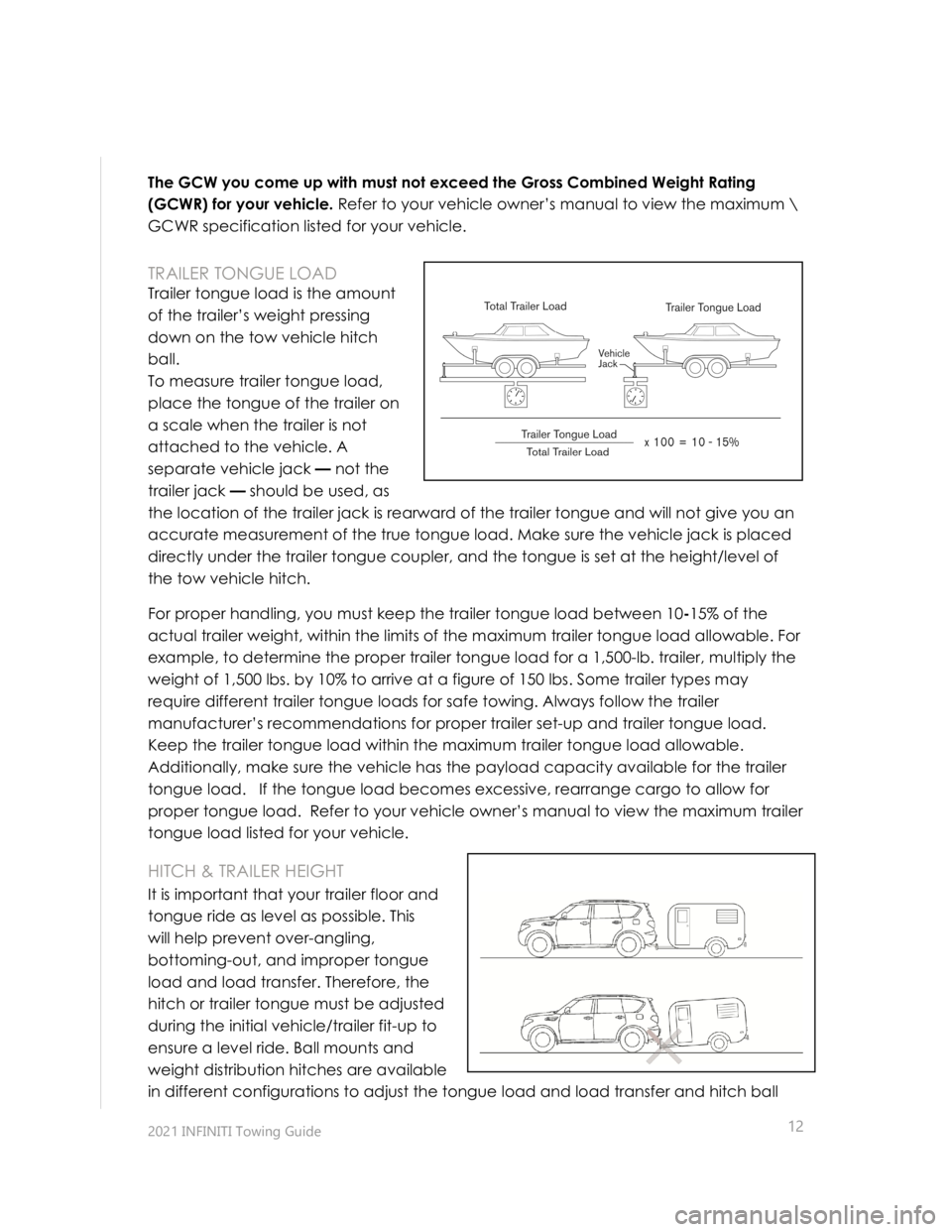
2021 INFINITI Towing Guide
12
The GCW you come up with must not exceed the Gross Combined Weight Rating
(GCWR) for your vehicle. Refer to your vehicle owner’s manual to view the maximum
GCWR specification listed for your vehicle.
TRAILER TONGUE LOAD
Trailer tongue load is the amount
of the trailer’s weight pressing
down on the tow vehicle hitch
ball.
To measure trailer tongue load,
place the tongue of the trailer on
a scale when the trailer is not
attached to the vehicle. A
separate vehicle jack — not the
trailer jack — should be used, as
the location of the trailer jack is rearward of the trailer tongue and will not give you an
accurate measurement of the true tongue load. Make sure the vehicle jack is placed
directly under the trailer tongue coupler, and the tongue is set at the height/level of
the tow vehicle hitch.
For proper handling, you must keep the trailer tongue load between 10-15% of the
actual trailer weight, within the limits of the maximum trailer tongue load allowable. For
example, to determine the proper trailer tongue load for a 1,500-lb. trailer, multiply the
weight of 1,500 lbs. by 10% to arrive at a figure of 150 lbs. Some trailer types may
require different trailer tongue loads for safe towing. Always follow the trailer
manufacturer’s recommendations for proper trailer set-up and trailer tongue load.
Keep the trailer tongue load within the maximum trailer tongue load allowable.
Additionally, make sure the vehicle has the payload capacity available for the trailer
tongue load. If the tongue load becomes excessive, rearrange cargo to allow for
proper tongue load. Refer to your vehicle owner’s manual to view the maximum trailer
tongue load listed for your vehicle.
HITCH & TRAILER HEIGHT
It is important that your trailer floor and
tongue ride as level as possible. This
will help prevent over-angling,
bottoming-out, and improper tongue
load and load transfer. Therefore, the
hitch or trailer tongue must be adjusted
during the initial vehicle/trailer fit-up to
ensure a level ride. Ball mounts and
weight distribution hitches are available
in different configurations to adjust the tongue load and load transfer and hitch ball
Page 14 of 26
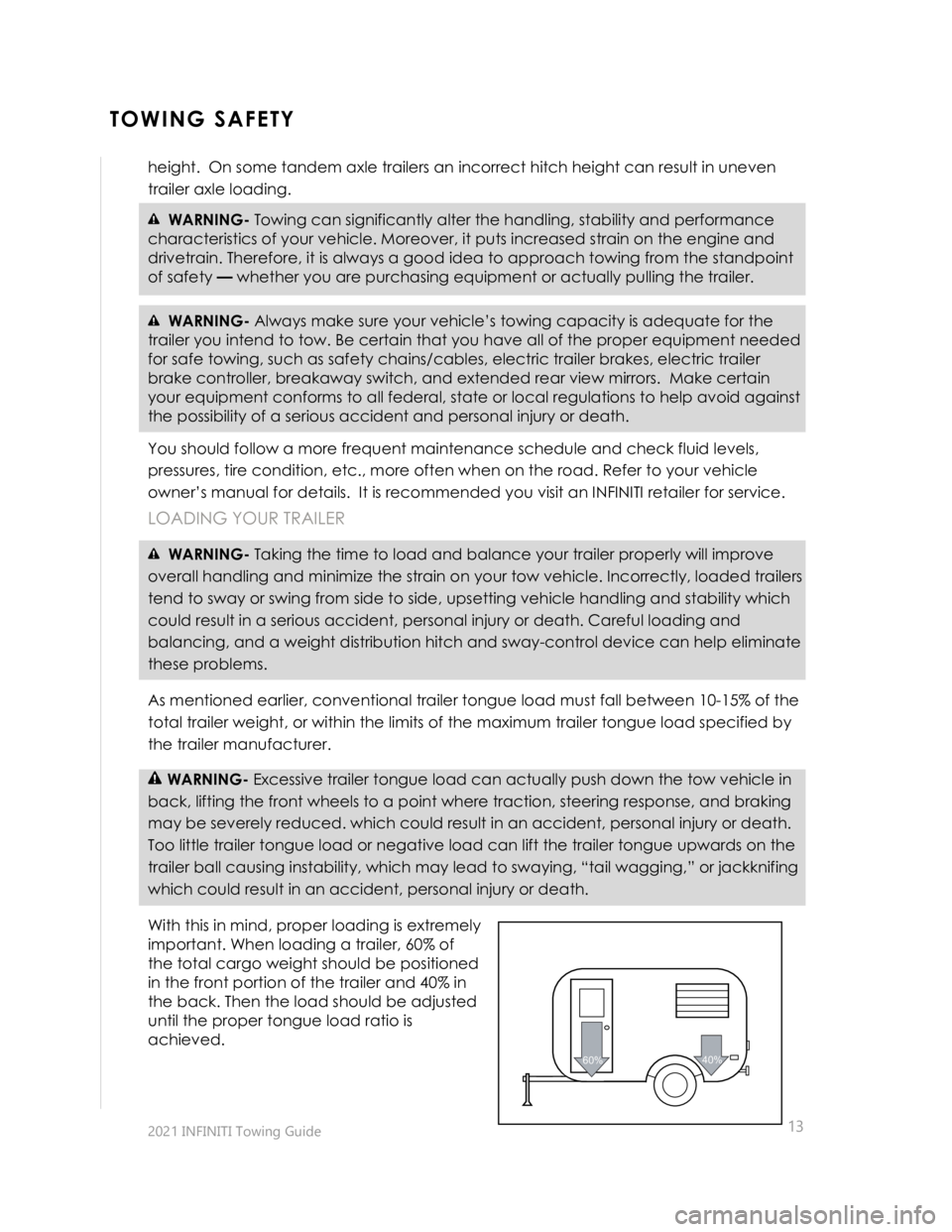
2021 INFINITI Towing Guide
13
height. On some tandem axle trailers an incorrect hitch height can result in uneven
trailer axle loading.
WARNING- Towing can significantly alter the handling, stability and performance
characteristics of your vehicle. Moreover, it puts increased strain on the engine and
drivetrain. Therefore, it is always a good idea to approach towing from the standpoint
of safety — whether you are purchasing equipment or actually pulling the trailer.
WARNING- Always make sure your vehicle’s towing capacity is adequate for the
trailer you intend to tow. Be certain that you have all of the proper equipment needed
for safe towing, such as safety chains/cables, electric trailer brakes, electric trailer
brake controller, breakaway switch, and extended rear view mirrors. Make certain
your equipment conforms to all federal, state or local regulations to help avoid against
the possibility of a serious accident and personal injury or death.
You should follow a more frequent maintenance schedule and check fluid levels,
pressures, tire condition, etc., more often when on the road. Refer to your vehicle
owner’s manual for details. It is recommended you visit an INFINITI retailer for service.
LOADING YOUR TRAILER
WARNING- Taking the time to load and balance your trailer properly will improve
overall handling and minimize the strain on your tow vehicle. Incorrectly, loaded trailers
tend to sway or swing from side to side, upsetting vehicle handling and stability which
could result in a serious accident, personal injury or death. Careful loading and
balancing, and a weight distribution hitch and sway-control device can help eliminate
these problems.
As mentioned earlier, conventional trailer tongue load must fall between 10-15% of the
total trailer weight, or within the limits of the maximum trailer tongue load specified by
the trailer manufacturer.
WARNING- Excessive trailer tongue load can actually push down the tow vehicle in
back, lifting the front wheels to a point where traction, steering response, and braking
may be severely reduced. which could result in an accident, personal injury or death.
Too little trailer tongue load or negative load can lift the trailer tongue upwards on the
trailer ball causing instability, which may lead to swaying, “tail wagging,” or jackknifing
which could result in an accident, personal injury or death.
With this in mind, proper loading is extremely
important. When loading a trailer, 60% of
the total cargo weight should be positioned
in the front portion of the trailer and 40% in
the back. Then the load should be adjusted
until the proper tongue load ratio is
achieved.
60%40%
TOWING SAFETY
Page 15 of 26
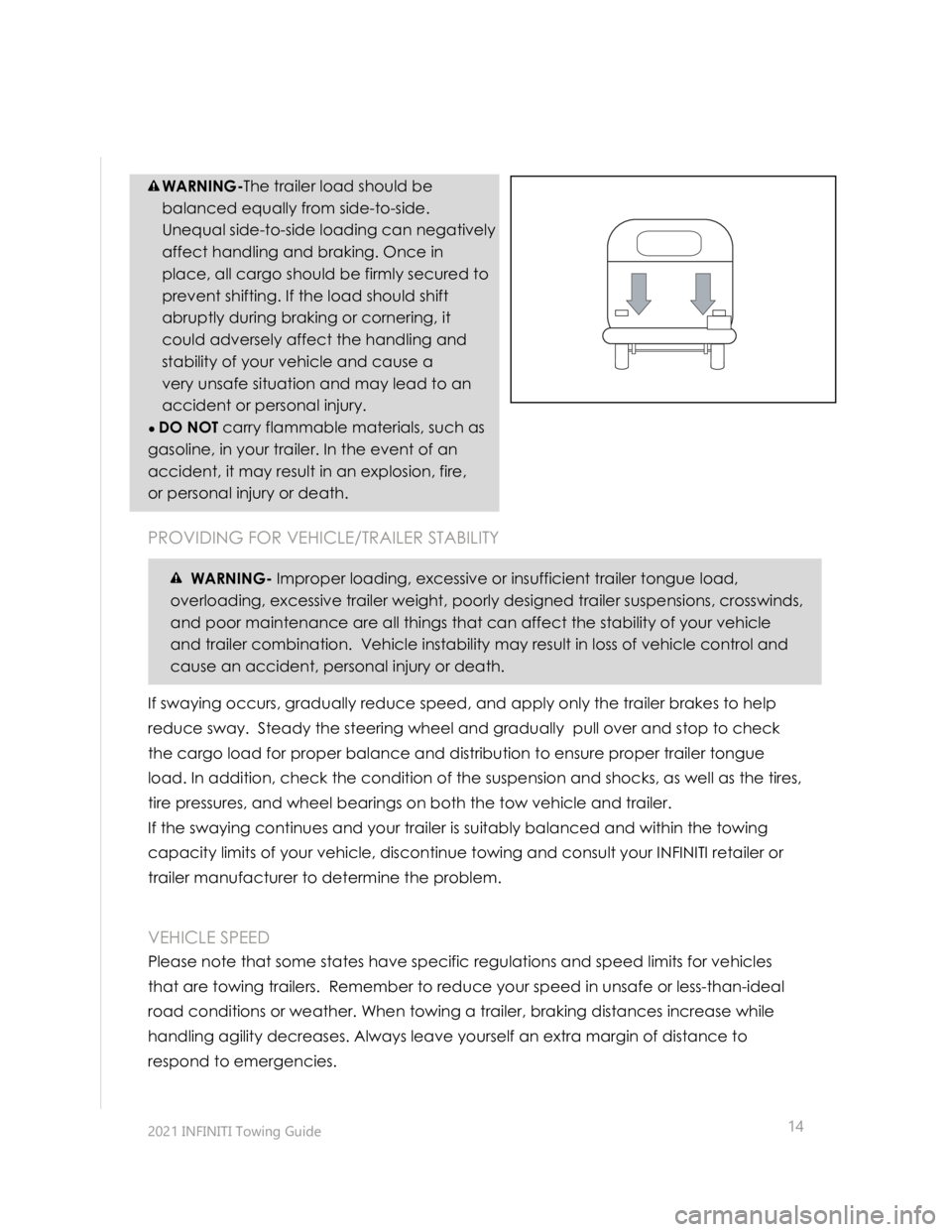
2021 INFINITI Towing Guide
14
WARNING-The trailer load should be
balanced equally from side-to-side.
Unequal side-to-side loading can negatively
affect handling and braking. Once in
place, all cargo should be firmly secured to
prevent shifting. If the load should shift
abruptly during braking or cornering, it
could adversely affect the handling and
stability of your vehicle and cause a
very unsafe situation and may lead to an
accident or personal injury.
● DO NOT carry flammable materials, such as
gasoline, in your trailer. In the event of an
accident, it may result in an explosion, fire,
or personal injury or death.
PROVIDING FOR VEHICLE/TRAILER STABILITY
WARNING- Improper loading, excessive or insufficient trailer tongue load,
overloading, excessive trailer weight, poorly designed trailer suspensions, crosswinds,
and poor maintenance are all things that can affect the stability of your vehicle
and trailer combination. Vehicle instability may result in loss of vehicle control and
cause an accident, personal injury or death.
If swaying occurs, gradually reduce speed, and apply only the trailer brakes to help
reduce sway. Steady the steering wheel and gradually pull over and stop to check
the cargo load for proper balance and distribution to ensure proper trailer tongue
load. In addition, check the condition of the suspension and shocks, as well as the tires,
tire pressures, and wheel bearings on both the tow vehicle and trailer.
If the swaying continues and your trailer is suitably balanced and within the towing
capacity limits of your vehicle, discontinue towing and consult your INFINITI retailer or
trailer manufacturer to determine the problem.
VEHICLE SPEED
Please note that some states have specific regulations and speed limits for vehicles
that are towing trailers. Remember to reduce your speed in unsafe or less-than-ideal
road conditions or weather. When towing a trailer, braking distances increase while
handling agility decreases. Always leave yourself an extra margin of distance to
respond to emergencies.
Page 16 of 26
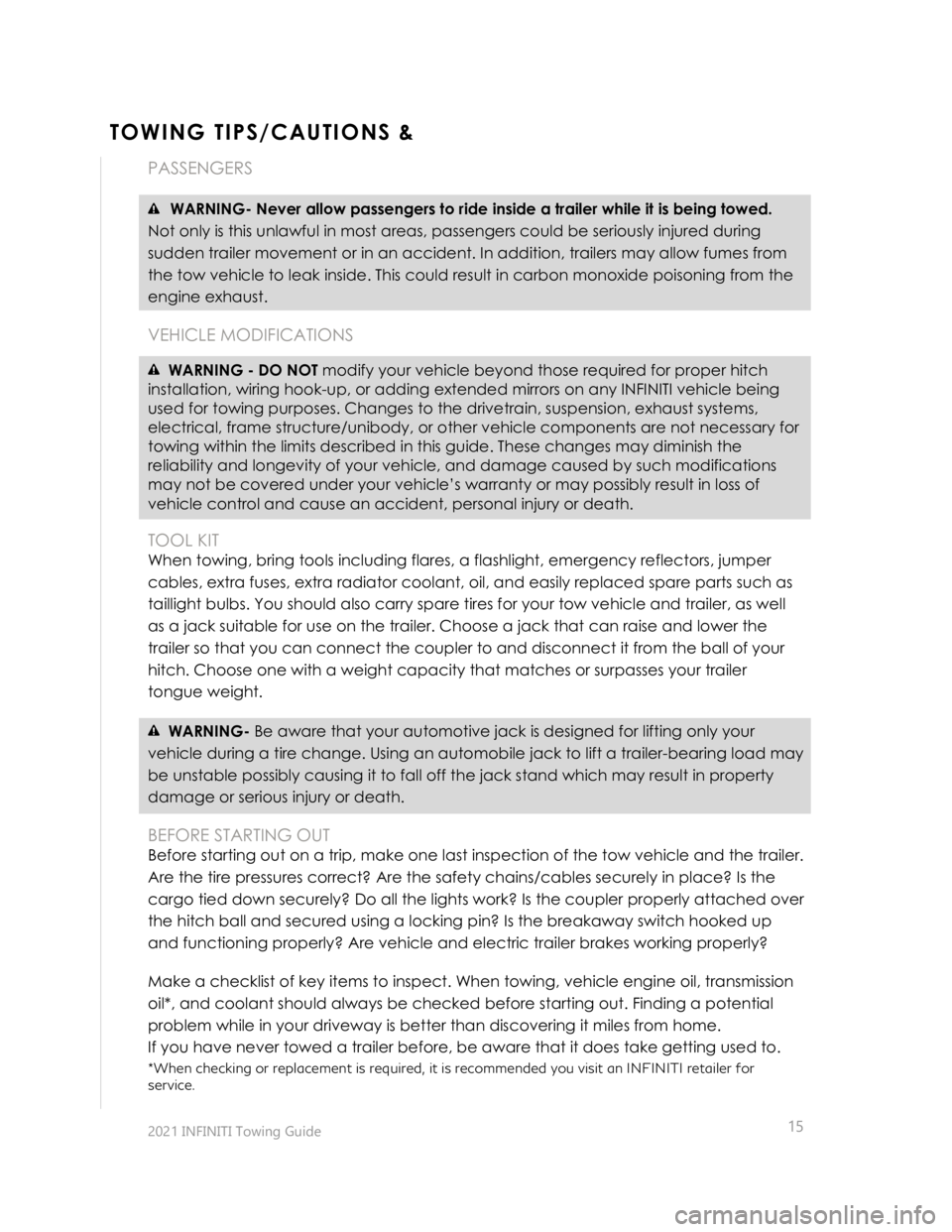
2021 INFINITI Towing Guide
15
PASSENGERS
WARNING- Never allow passengers to ride inside a trailer while it is being towed.
Not only is this unlawful in most areas, passengers could be seriously injured during
sudden trailer movement or in an accident. In addition, trailers may allow fumes from
the tow vehicle to leak inside. This could result in carbon monoxide poisoning from the
engine exhaust.
VEHICLE MODIFICATIONS
WARNING - DO NOT modify your vehicle beyond those required for proper hitch
installation, wiring hook-up, or adding extended mirrors on any INFINITI vehicle being
used for towing purposes. Changes to the drivetrain, suspension, exhaust systems,
electrical, frame structure/unibody, or other vehicle components are not necessary for
towing within the limits described in this guide. These changes may diminish the
reliability and longevity of your vehicle, and damage caused by such modifications
may not be covered under your vehicle’s warranty or may possibly result in loss of
vehicle control and cause an accident, personal injury or death.
TOOL KIT
When towing, bring tools including flares, a flashlight, emergency reflectors, jumper
cables, extra fuses, extra radiator coolant, oil, and easily replaced spare parts such as
taillight bulbs. You should also carry spare tires for your tow vehicle and trailer, as well
as a jack suitable for use on the trailer. Choose a jack that can raise and lower the
trailer so that you can connect the coupler to and disconnect it from the ball of your
hitch. Choose one with a weight capacity that matches or surpasses your trailer
tongue weight.
WARNING- Be aware that your automotive jack is designed for lifting only your
vehicle during a tire change. Using an automobile jack to lift a trailer-bearing load may
be unstable possibly causing it to fall off the jack stand which may result in property
damage or serious injury or death.
BEFORE STARTING OUT
Before starting out on a trip, make one last inspection of the tow vehicle and the trailer.
Are the tire pressures correct? Are the safety chains/cables securely in place? Is the
cargo tied down securely? Do all the lights work? Is the coupler properly attached over
the hitch ball and secured using a locking pin? Is the breakaway switch hooked up
and functioning properly? Are vehicle and electric trailer brakes working properly?
Make a checklist of key items to inspect. When towing, vehicle engine oil, transmission
oil*, and coolant should always be checked before starting out. Finding a potential
problem while in your driveway is better than discovering it miles from home.
If you have never towed a trailer before, be aware that it does take getting used to.
*When checking or replacement is required, it is recommended you visit an INFINITI retailer for
service.
TOWING TIPS/CAUTIONS &
Page 21 of 26
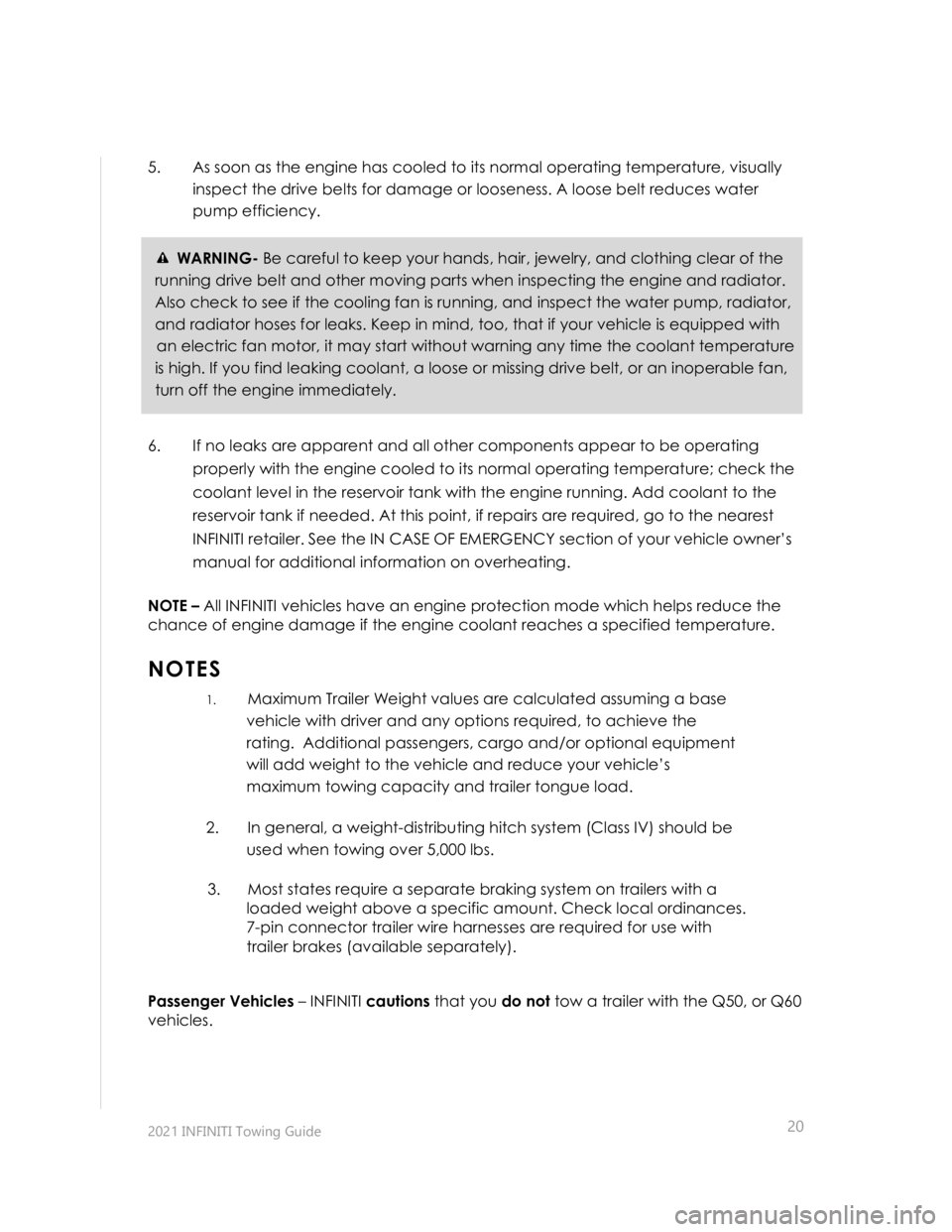
2021 INFINITI Towing Guide
20
5. As soon as the engine has cooled to its normal operating temperature, visually
inspect the drive belts for damage or looseness. A loose belt reduces water
pump efficiency.
WARNING- Be careful to keep your hands, hair, jewelry, and clothing clear of the
running drive belt and other moving parts when inspecting the engine and radiator.
Also check to see if the cooling fan is running, and inspect the water pump, radiator,
and radiator hoses for leaks. Keep in mind, too, that if your vehicle is equipped with
an electric fan motor, it may start without warning any time the coolant temperature
is high. If you find leaking coolant, a loose or missing drive belt, or an inoperable fan,
turn off the engine immediately.
6. If no leaks are apparent and all other components appear to be operating
properly with the engine cooled to its normal operating temperature; check the
coolant level in the reservoir tank with the engine running. Add coolant to the
reservoir tank if needed. At this point, if repairs are required, go to the nearest
INFINITI retailer. See the IN CASE OF EMERGENCY section of your vehicle owner’s
manual for additional information on overheating.
NOTE – All INFINITI vehicles have an engine protection mode which helps reduce the
chance of engine damage if the engine coolant reaches a specified temperature.
NOTES
Passenger Vehicles – INFINITI cautions that you do not tow a trailer with the Q50, or Q60
vehicles.
1. Maximum Trailer Weight values are calculated assuming a base
vehicle with driver and any options required, to achieve the
rating. Additional passengers, cargo and/or optional equipment
will add weight to the vehicle and reduce your vehicle’s
maximum towing capacity and trailer tongue load.
2. In general, a weight-distributing hitch system (Class IV) should be
used when towing over 5,000 lbs.
3. Most states require a separate braking system on trailers with a
loaded weight above a specific amount. Check local ordinances.
7-pin connector trailer wire harnesses are required for use with
trailer brakes (available separately).
Page 22 of 26

2021 INFINITI Towing Guide
21 Other Recommendations and Information – Towing performance and speed are
affected by vehicle payload, tow weight, road grades, and weather conditions,
including high temperatures. See your vehicle owner’s manual for details.
TOWING GLOSSARY
BALL MOUNT A bar that holds the hitch ball and is inserted into the hitch receiver.
BREAKAWAY SWITCH A safety device using a trailer battery that automatically applies the trailer’s
brakes if it should accidentally become separated from the tow vehicle.
A breakaway switch may be used with both electric or surge trailer brake
systems.
BUMPER HITCH A reinforced bumper designed to accommodate a hitch ball.
ELECTRIC TRAILER
BRAKES When the brakes on a tow vehicle are applied, an electric current is sent to
an actuator which applies the trailer’s brakes.
ELECTRIC TRAILER
BRAKE CONTROLLER A device that controls the electric trailer brakes.
GROSS AXLE
WEIGHT RATING
(GAWR) The maximum amount of weight each vehicle axle (front and rear) is
designed to safely carry.
GROSS COMBINED
WEIGHT RATING
(GCWR) The maximum allowable combined weight of the vehicle and trailer,
including passengers and all cargo.
GROSS VEHICLE
WEIGHT RATING
(GVWR) The maximum allowable weight of the vehicle, including passengers, cargo,
fuel, hitch, trailer tongue load, and any optional equipment.
HITCH BALL
A ball that connects the trailer to the tow vehicle hitch that provides the
means by which the trailer pivots during cornering. Available in a number of
sizes and weight capacities, it must correspond to the trailer coupler size, and
have a sufficient capacity rating for the trailer being pulled.
RECEIVER HITCH A frame- or structure-mounted hitch with a receiver that allows removal of the
ball mount.
SAFETY CHAINS/CABLES Provides an emergency connection between the tow vehicle and the trailer,
should the trailer become disengaged for any reason.
SURGE BRAKES
Hydraulic-type braking system activated by inertia. As the tow vehicle begins
to brake, the trailer pushes against the hitch ball, consequently activating the
trailer brakes.
TRAILER
TONGUE/COUPLER The part of the trailer that extends forward to meet the tow vehicle, and
carries the coupler assembly.